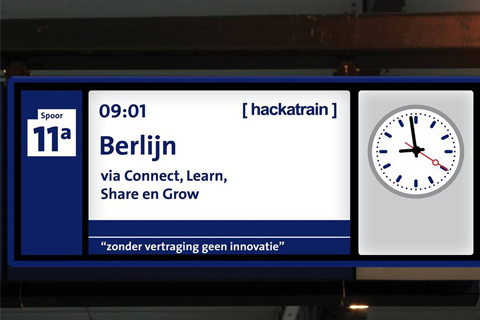Generic
Artificial intelligence on a high speed train
Share this post:
A few weeks ago the Dutch Railways (NS) asked me to join Hackatrain, a hackathon traveling to one of Europe’s coolest tech festivals, Berlin’s Tech Open Air. Going 200 kilometers per hour we were challenged to improve the customer satisfaction of European train travelers. Around a 100 participants made up 21 teams of developers, entrepreneurs, designers, students, hobbyists, and enterprise developers.

Teams had only a few hours to come up with a solution for a problem we all know: finding your way around foreign trains and public transport networks. Organizer ProRail gave the teams data on trains, stations, travelers and customer satisfaction. The data showed international train travelers don’t like transfers very much and the teams dove into building a smartphone app to make those transfers easier.
Using an app based on Watson to improve public transport has been done before. Earlier this year, IBM helped to create an app that would use Watson Visual Recognition to inform travelers about congestion on London bus routes. This time, though we brainstormed about other AI tools on the Bluemix platform, we talked about integrating a chatbot like Watson Assistant, a service that lets you quickly and easily create chatbots even if you don’t have any machine learning experience. All you need to do is provide examples of intents and entities which are used to respond to the end-user questions. The service uses these to train its machine learning models at the back.

You can also add custom responses by using the dialogue-build tool and, to get you started, there is a bunch of sample applications and code snippets with easy-to-use tools to build your chatbots. The application understands natural language and responds to customers in human-like conversation, in multiple languages and it seamlessly connects to messaging channels, web environments and social networks to make scaling easy.
But what if a traveler has two bags and can’t free his hand to hold his phone? Using our Speech APIs you can build an app a traveler can interact with through his headset. These APIs can automatically transcribe audio from 7 languages in real time. This comes in handy when you’re servicing international travelers! It rapidly identifies and transcribes what is being discussed, even from lower quality audio, across a variety of audio formats and programming interfaces (HTTP REST, Websocket, and Asynchronous HTTP). It works the other way around too: speech can deliver a seamless voice interaction that caters to your audience with control over every word. This way traveler won’t get lost.
And if we build in GEO-location we can offer the traveller real-time advice. For example analyzing whether the user has enough time to get a sandwich and showing the best spots to get a quick coffee. A great idea was to integrate discounts and coupons for shops at the station. A nice add-on for the user and a great marketing channel for the railways.
The winning team developed a really cool solution. This solution will be able to guide travelers through the station in their own language and troubleshoot any questions travellers may have bringing the entire customer experience to a new level.
Tech Open Air
Why Berlin? With the train we went to Tech Open Air, a festival in Berlin with a lot of crazy, creative tech people, including us. My IBM colleague John Smith gave a workshop on AI for creative industries and showed how and if creativity can be analyzed and recreated methodically. He also talked about compelling advantages for using artificial intelligence in the creation of artistic works. Already we’ve seen AI techniques do stunning stuff like supporting the process of making movie trailers and automatically generating highlight videos of sports games.

So what are you waiting for? Start coding and add cognitive into your apps! Go to http://developer.ibm.com/code

IBM Developer Advocate
Is regulation enabling or hindering innovation in the financial services industry?
Anne Leslie, Cloud Risk & Controls Leader Europe, IBM Cloud for Financial Services Europe’s financial services sector is in the throes of wide scale digital transformation – a transition being accelerated by the growing adoption of digital solutions and services to help keep up with the demands of digitally savvy consumers. While there can be […]
The Digital Operational Resilience Act for Financial Services: Harmonised rules, broader scope of application
The Digital Operational Resilience Act – what and why As part of the European Commission’s Digital Finance Package, the new Digital Operational Resilience Act, or in short DORA, will come into force in the coming period. The aim of DORA is to establish uniform requirements across the EU that improve the cybersecurity and operational resilience […]
Banking on empathy
Suppose you’re owning a small boutique wine shop and have gone through two difficult years because of the Covid-19 pandemic. As the pandemic seems to be on its way back, it is time to revitalize the shop. And this causes direct a huge challenge: the wine stock needs to be replenished but you have used […]


